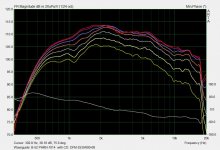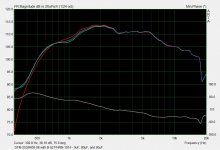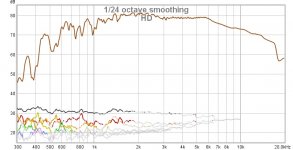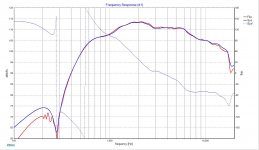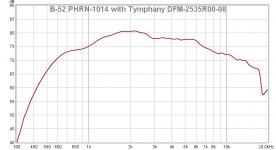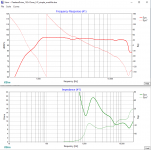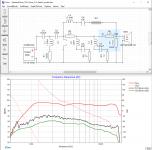So I'm new to speaker design and am hoping fellow forum members can assist with a simple 2-way build.
I have built several speaker kits to date, but have never designed anything on my own and thought I try my hand at something (hopefully) simple:
I have the following parts on hand:
Waveguide B-52 PHRN-1014: B-52 PHRN-1014 1" Horn 10" x 14" Bolt-On
Based on posts on other threads, many indicate this might be a clone of the NLA QSC HPR152i
For Compression Driver, I have the following Tymphany DFM-2535R00-08
Now, I have the following questions:
1) When taking measurements of the WG + driver, is there is a need to include a series capacitor to protect the CD? I'm not measuring at loud volumes on anything. I should have asked this question before, but I ended up taking a few measurements already.
2) If the answer to the above question is "Yes" - would it not impact the measured phase? I'm currently measure using ARTA's semi-dual method. If I use a 50uf or 80uf - it seems to impact the response (albeit slightly). How does one typically account for the impact of the protection capacitor on the measured response and phase, when one gets to the crossover design stage.
I've attached a couple of measurements, one showing the impact of including a protection capacitor, and the other showing the off-axis response to 60 degrees. - Please disregard the SPL Magnitude - I didn't take these measurements at 110db.
Lastly, I'm looking for (mid-) woofer recommendation. Don't want to spend too much since it's my first go. So far, I have $25 for the waveguides and $80 for the CDs. I'm budgeting $200 for the woofers.
Depending on the feedback I get in regards to the recommended safe crossover point for the CDw/WG, if its over 1200hz, it is my understanding that I should go with a woofer no larger than 12" (to make sure the center to center distance between the CD and the woofer is less than the wavelength at the crossover point).
Thoughts?
I have built several speaker kits to date, but have never designed anything on my own and thought I try my hand at something (hopefully) simple:
I have the following parts on hand:
Waveguide B-52 PHRN-1014: B-52 PHRN-1014 1" Horn 10" x 14" Bolt-On
Based on posts on other threads, many indicate this might be a clone of the NLA QSC HPR152i
For Compression Driver, I have the following Tymphany DFM-2535R00-08
Now, I have the following questions:
1) When taking measurements of the WG + driver, is there is a need to include a series capacitor to protect the CD? I'm not measuring at loud volumes on anything. I should have asked this question before, but I ended up taking a few measurements already.
2) If the answer to the above question is "Yes" - would it not impact the measured phase? I'm currently measure using ARTA's semi-dual method. If I use a 50uf or 80uf - it seems to impact the response (albeit slightly). How does one typically account for the impact of the protection capacitor on the measured response and phase, when one gets to the crossover design stage.
I've attached a couple of measurements, one showing the impact of including a protection capacitor, and the other showing the off-axis response to 60 degrees. - Please disregard the SPL Magnitude - I didn't take these measurements at 110db.
Lastly, I'm looking for (mid-) woofer recommendation. Don't want to spend too much since it's my first go. So far, I have $25 for the waveguides and $80 for the CDs. I'm budgeting $200 for the woofers.
Depending on the feedback I get in regards to the recommended safe crossover point for the CDw/WG, if its over 1200hz, it is my understanding that I should go with a woofer no larger than 12" (to make sure the center to center distance between the CD and the woofer is less than the wavelength at the crossover point).
Thoughts?
Attachments
I'd personally aim initially for about 1.1k or 1kHz as crossover, but exactly where will depend on the measurements you make of the drivers in the cabinet. You can make measurements of a CD without a protection cap but, of course keep the level reasonable. I even do it at the 2.83Vrms standard level, which is quite loud. Ask my wife!
A good woofer I'd look at might be the Eminence 2512 Deltalite, would help keep the sensitivity up. Will take some shaping in the crossover, but if you have good measurements and a good crossover design program (Xsim or PCD or VituixCAD for example), that's not really hard to do. I would make at least 3 separate models (and sets of measurements), though, one at 0deg on-axis, one at about 20deg (horizontal) off-axis and one at about 40deg off-axis so you can optimize for off-axis response as well as the on-axis. If you plan to run your speakers with toe-in (advised), then focus particularly on the 20deg model choosing crossover points that work best also at 0deg and 40deg.
A good woofer I'd look at might be the Eminence 2512 Deltalite, would help keep the sensitivity up. Will take some shaping in the crossover, but if you have good measurements and a good crossover design program (Xsim or PCD or VituixCAD for example), that's not really hard to do. I would make at least 3 separate models (and sets of measurements), though, one at 0deg on-axis, one at about 20deg (horizontal) off-axis and one at about 40deg off-axis so you can optimize for off-axis response as well as the on-axis. If you plan to run your speakers with toe-in (advised), then focus particularly on the 20deg model choosing crossover points that work best also at 0deg and 40deg.
Thanks for the recommendation Bwaslo.
Yes - the measurements were definitely taken at low volumes. I plan on taking measurements out to at least 60deg (like the measurements included above) once I have the enclosure built.
I'll look into the Eminence. They are slightly on the pricey side for me (at $155/each), but maybe their performance will justify the cost.
I was curious how something like the Dayton PA310-8 would fare - they are currently on sale for $60 each.
Yes - the measurements were definitely taken at low volumes. I plan on taking measurements out to at least 60deg (like the measurements included above) once I have the enclosure built.
I'll look into the Eminence. They are slightly on the pricey side for me (at $155/each), but maybe their performance will justify the cost.
I was curious how something like the Dayton PA310-8 would fare - they are currently on sale for $60 each.
This is my understanding.....
-tymphany-DFM-2535R00-08 has small 1.4" diameter dome
A 10" midwoofer like the $140 Deltalite_II 2510 with a crossove frequency around 1.5-1.6kHz selected to match the polar response of the B-52 PHRN-1014 waveguide would be a good complement to your DFM-2535R00-08.
The $57 Faital 10FE200 with Fs=55Hz and Qts=0.6 = BIG box with modest bass
This CD has also been used at lower crossover frequencies with 12" midbass for modest demand home speakers. Polar measurements for 1250Hz crossover look very good. I would experiment with BW3 and LR4 circuits to best protect this 1.4" diameter CD.
------------
-tymphany-DFM-2544R00-08 has 1.75" diameter dome
A 12" midwoofer like the Eminence $155 DeltaLite 2512_II or superior $205 Kappalite 3012HO with a crossover frequency around 1.2-1.3kHz selected to match the polar response of the B-52 PHRN-1014 waveguide would be a good complement to a DFM-2544R00-08 .
-tymphany-DFM-2535R00-08 has 1.4" diameter dome
Peerless by Tymphany DFM-2535R00-08 Compression Driver | audioXpress
-tymphany-DFM-2544R00-08 has 1.75" diameter dome
Test Bench: Peerless by Tymphany DFM-2544R00-08 Compression Driver | audioXpress
-tymphany-DFM-2535R00-08 has small 1.4" diameter dome
A 10" midwoofer like the $140 Deltalite_II 2510 with a crossove frequency around 1.5-1.6kHz selected to match the polar response of the B-52 PHRN-1014 waveguide would be a good complement to your DFM-2535R00-08.
The $57 Faital 10FE200 with Fs=55Hz and Qts=0.6 = BIG box with modest bass
This CD has also been used at lower crossover frequencies with 12" midbass for modest demand home speakers. Polar measurements for 1250Hz crossover look very good. I would experiment with BW3 and LR4 circuits to best protect this 1.4" diameter CD.
------------
-tymphany-DFM-2544R00-08 has 1.75" diameter dome
A 12" midwoofer like the Eminence $155 DeltaLite 2512_II or superior $205 Kappalite 3012HO with a crossover frequency around 1.2-1.3kHz selected to match the polar response of the B-52 PHRN-1014 waveguide would be a good complement to a DFM-2544R00-08 .
-tymphany-DFM-2535R00-08 has 1.4" diameter dome
Peerless by Tymphany DFM-2535R00-08 Compression Driver | audioXpress
-tymphany-DFM-2544R00-08 has 1.75" diameter dome
Test Bench: Peerless by Tymphany DFM-2544R00-08 Compression Driver | audioXpress
Thanks LineSource -
I did also consider the DMF-2544R00-08. I know it can dig a little lower and has twice the power handling. However, I wasn't sure if the B-52 PHRN-1014 waveguide would provide much boost below 1.2Khz. So even though the 2544 could play lower, I wasn't sure that, when combined with the WG, will I have a nice smooth (workable) response, or will I have a little bump in the response because the driver can continue playing below the cut-off frequency of the WG.
I'm certainly within the return window for the DFM-2535, if you think the DFM-2544 would be a better route for a 2-way. It's only marginally more expensive.
I'll also model out the Deltalite 2510 vs DeltaLite 2512.
This build is mainly for our living room for some background music. While I do play some tracks loud from time to time - I'm not chasing after the same SPL that some of my AVSForum member DIY enthusiast chase
I did also consider the DMF-2544R00-08. I know it can dig a little lower and has twice the power handling. However, I wasn't sure if the B-52 PHRN-1014 waveguide would provide much boost below 1.2Khz. So even though the 2544 could play lower, I wasn't sure that, when combined with the WG, will I have a nice smooth (workable) response, or will I have a little bump in the response because the driver can continue playing below the cut-off frequency of the WG.
I'm certainly within the return window for the DFM-2535, if you think the DFM-2544 would be a better route for a 2-way. It's only marginally more expensive.
I'll also model out the Deltalite 2510 vs DeltaLite 2512.
This build is mainly for our living room for some background music. While I do play some tracks loud from time to time - I'm not chasing after the same SPL that some of my AVSForum member DIY enthusiast chase
Since you want good 2-way bass,
and since the B52 waveguide is 14" wide,
and since you can exchange your 1.4" DFM-2535R00-08 for the 1.75" DMF-2544R00-08,
it seems logical to get the DMF-2544R00-08 and purchase a 12" midwoofer like the Eminence DeltaLite 2512-II to help justify the exchange with the store.
Eminence DeltaLite 2512-II will produce -F3 =43Hz in about 4.5-5cuft ported cabinet. 18" wide cabinets have a "good look" in most rooms, tall and reasonable depth yields 4-5cuft. You can find a few example EconoWave crossovers for the DeltaLite 2512-II at 1200-1300Hz.
tymphany-DFM-2544R00-08 has 1.75" diameter dome
Eminence DeltaLite 2512-II woofer -F3~44Hz
B-52 PHRN-1014 waveguide
and since the B52 waveguide is 14" wide,
and since you can exchange your 1.4" DFM-2535R00-08 for the 1.75" DMF-2544R00-08,
it seems logical to get the DMF-2544R00-08 and purchase a 12" midwoofer like the Eminence DeltaLite 2512-II to help justify the exchange with the store.
Eminence DeltaLite 2512-II will produce -F3 =43Hz in about 4.5-5cuft ported cabinet. 18" wide cabinets have a "good look" in most rooms, tall and reasonable depth yields 4-5cuft. You can find a few example EconoWave crossovers for the DeltaLite 2512-II at 1200-1300Hz.
tymphany-DFM-2544R00-08 has 1.75" diameter dome
Eminence DeltaLite 2512-II woofer -F3~44Hz
B-52 PHRN-1014 waveguide
DK,
I'd think very carefully whether or not to trade this raw response
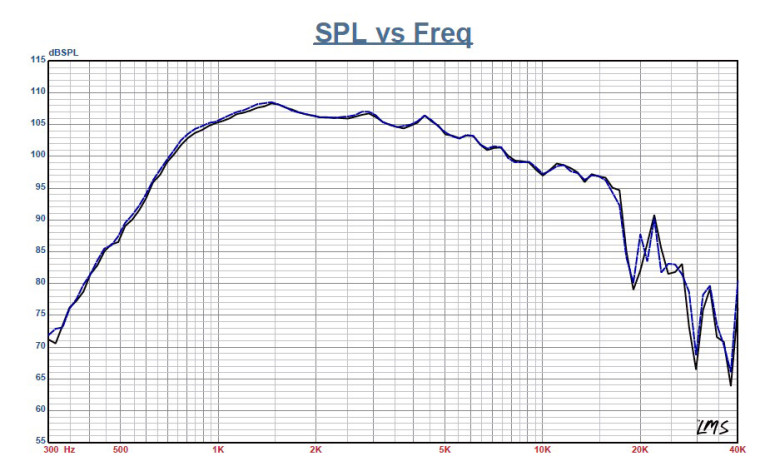
for this one .
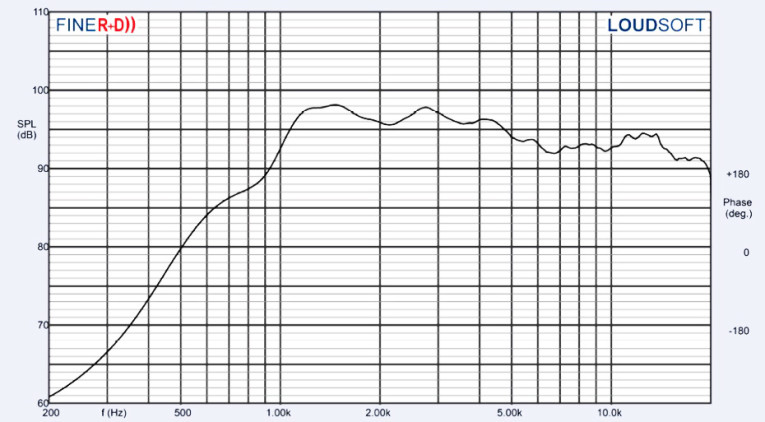
That second curve will require a bit more tonal shaping ( iow; 2 to 3 PEQ notchs ) to hammer into a flattish response ( though it's eminently do-able ).
The ( proto ) introductory thread ( created over at TechTalk called Impressive New Compression Driver where we put the Tymphany DFM2535 through it's paces also produced a pretty consistent opinion that the driver would be easy to EQ & HiPass due to it's quite linear response and low Fs .
Here are some examples :
 and
and
 and
and
 and
and

You'll recognize the 4th pic in the series as an XSim prediction .
The point of all my XSim predictions was to show how easy it is to get good looking HF curves using the Tymphany 2535 on the PRV ( 152i clone ) .
That XSim prediction was produced by this simple HP network;

A major concern I have is that your Tymphany DFM2535 ( on the B52 version of the 152i Clone ) is nowhere near as linear as I have come to believe this driver/horn combo should deliver.
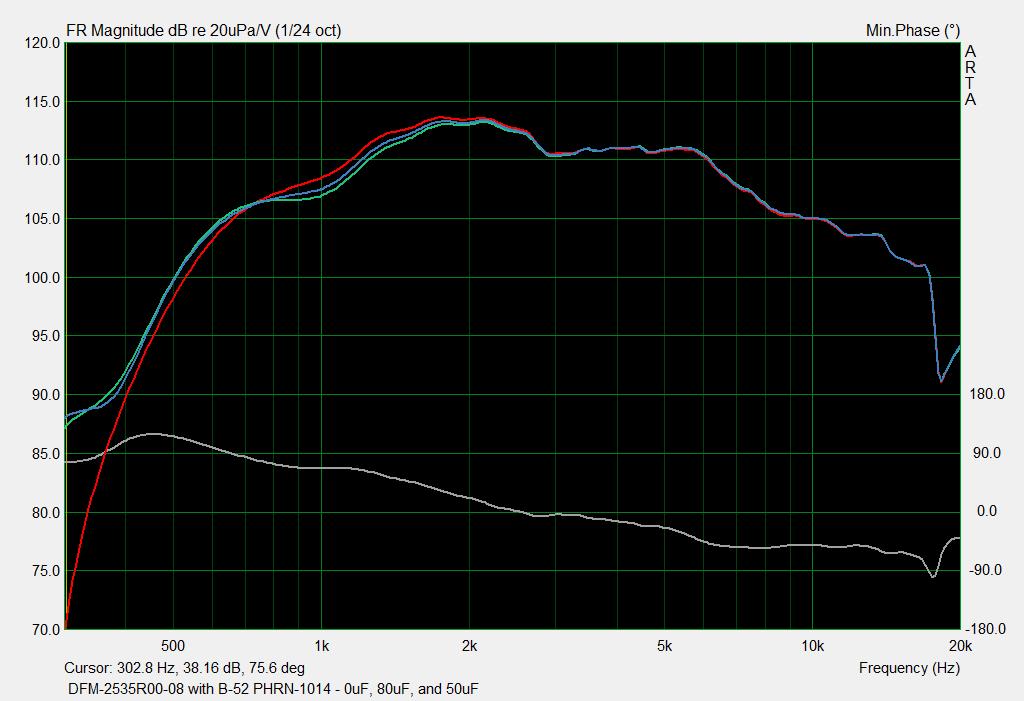
I'm wondering if there's a difference in your drivers ( compared to our 2016 vintage models ) and/or whether your B52 horn is injecting a lot more ripple into the drivers raw response.
I believe Bill Waslo still uses & promotes these drivers, so maybe he can offer an opinion if their 2019 response is the same as back in 2016.

I'd think very carefully whether or not to trade this raw response

for this one .

That second curve will require a bit more tonal shaping ( iow; 2 to 3 PEQ notchs ) to hammer into a flattish response ( though it's eminently do-able ).
The ( proto ) introductory thread ( created over at TechTalk called Impressive New Compression Driver where we put the Tymphany DFM2535 through it's paces also produced a pretty consistent opinion that the driver would be easy to EQ & HiPass due to it's quite linear response and low Fs .
Here are some examples :



You'll recognize the 4th pic in the series as an XSim prediction .
The point of all my XSim predictions was to show how easy it is to get good looking HF curves using the Tymphany 2535 on the PRV ( 152i clone ) .
That XSim prediction was produced by this simple HP network;
A major concern I have is that your Tymphany DFM2535 ( on the B52 version of the 152i Clone ) is nowhere near as linear as I have come to believe this driver/horn combo should deliver.
I'm wondering if there's a difference in your drivers ( compared to our 2016 vintage models ) and/or whether your B52 horn is injecting a lot more ripple into the drivers raw response.
I believe Bill Waslo still uses & promotes these drivers, so maybe he can offer an opinion if their 2019 response is the same as back in 2016.
I'm wondering if there's a difference in your drivers ( compared to our 2016 vintage models ) and/or whether your B52 horn is injecting a lot more ripple into the drivers raw response.
I believe Bill Waslo still uses & promotes these drivers, so maybe he can offer an opinion if their 2019 response is the same as back in 2016.

Earl,
Thanks for the link and measurement curves.
I measured with the pairs of divers on the pair of horns and they measured near identical (only slight difference above 18Khz).
I don't know why I'm getting that bump centered around 2Khz (or maybe 2Khz fine and I'm getting a dip around 3K-4K?).
Don't know what's going on?
Earl,
<<<snip>>>
I measured with the pairs of divers on the pair of horns and they measured near identical (only slight difference above 18Khz).
I don't know why I'm getting that bump centered around 2Khz (or maybe 2Khz fine and I'm getting a dip around 3K-4K?).
<<<snip>>>
Even though you've measured both drivers on both new horns there may be something wrong with each driver ( such as a poorly fitted diaphragm ).
I would remeasure ( at least one of them ) using REW this time and then have a look at the drivers distortion profile.
The notch at around 3K ( which I find quite abnormal ) could be caused by a rubbing diaphragm.
- If that's the case you'll see a dramatic spike in 3rd Harmonic distortion ( corresponding to the notch area ).
You'll need to re-seat the diaphragm(s) to minimize the problem .
I would return those drivers if you can't fix their response anomalies ( and bring them closer in response to the graphs that I previously presented ) .


Thanks, Earl.
I did take new measurements of both drivers/horns last night using a different setup.
Previously, I used ARTA + Mobile Pre USB + CrossSpectrum Calibrated Mic (Dual-Mode).
Last night I measured with MiniDSP Umik-1 and REW.
The measurements between the two systems were near identical (i.e., less than 0.25db variance between 500hz - 17,000hz).
I forgot to check the distortion profile. I'll do that tonight and report back.
Maybe something has changed in the drivers over the last couples years?
I did take new measurements of both drivers/horns last night using a different setup.
Previously, I used ARTA + Mobile Pre USB + CrossSpectrum Calibrated Mic (Dual-Mode).
Last night I measured with MiniDSP Umik-1 and REW.
The measurements between the two systems were near identical (i.e., less than 0.25db variance between 500hz - 17,000hz).
I forgot to check the distortion profile. I'll do that tonight and report back.
Maybe something has changed in the drivers over the last couples years?
With Umik and Room EQ Wizard
Earl,
See attached pic. These measurements were taken with REW and Umik, 1-meter from WG, with 100uF cap for protection.
I've also included a comparison against the measurements using ARTA.
Earl,
See attached pic. These measurements were taken with REW and Umik, 1-meter from WG, with 100uF cap for protection.
I've also included a comparison against the measurements using ARTA.
Attachments
Last edited:
DK,
Thanks for the pics.
BTW for this exercise, ( using REW to spot diaphragm mounting problems) you might as well not display THD + all the harmonics that are higher than 3HD > as well as that noise floor "masking feature" ).
Can you also post your REW file ( for the above ) as well as a .zma file for one of your drivers mounted on this B52 horn.
I've already created a 1K HiPass ( + contour ) filter for your driver/horn combo ( that I'll post later today ) once I get some real files ( from you to work from ).
Here's a teaser of the possible linearity ( when using passive PEQ's to hammer out a flattish response ).
- This uses a traced FR file ( from your REW trace along with my own .zma file ) > so it's only partially accurate .


Thanks for the pics.
BTW for this exercise, ( using REW to spot diaphragm mounting problems) you might as well not display THD + all the harmonics that are higher than 3HD > as well as that noise floor "masking feature" ).
Can you also post your REW file ( for the above ) as well as a .zma file for one of your drivers mounted on this B52 horn.
I've already created a 1K HiPass ( + contour ) filter for your driver/horn combo ( that I'll post later today ) once I get some real files ( from you to work from ).
Here's a teaser of the possible linearity ( when using passive PEQ's to hammer out a flattish response ).
- This uses a traced FR file ( from your REW trace along with my own .zma file ) > so it's only partially accurate .
Attachments
Last edited:
Thanks Dk,
Your impedance file ( for that driver on the 152i clone ) was similar to mine .
It hardly changed the network design ( if at all ).
The updated frd file was a bit different ( when compared to my traced version of your earlier file version ) .
Anyways, here's a HiPass design using your files ( it's about as complicated as a typical sota JBL hipass for their current crop of speakers ) .
Obviously all these parts represent just "one way to skin the cat".

I've also included the XSim file for you to play with.
The black ( my 2016 measurement for my driver ) & green traces ( your driver ) are for the sake of comparing the 2016 DFM2535 response to your newer example.
I can see that they are more similar than different.
- They both have a "weakness/notch" at 3K , and peaks at 2K & @5.5K .
- Your driver example has a bit more rolled off UHF, while the above noted similarities are more exaggerated.
Anyways, what I get from this exercise is that I'll continue to recommend these drivers ( even though they do need PEQ to get back to flattish response ).
Each PEQ costs $10 - $15.00 using modestly priced Dayton parts, so that has to be factored into whether ( or not ) one is better off adding $30 to 40 to buy a more expensive driver ( all the while hoping for greater linearity ).

Your impedance file ( for that driver on the 152i clone ) was similar to mine .
It hardly changed the network design ( if at all ).
The updated frd file was a bit different ( when compared to my traced version of your earlier file version ) .
Anyways, here's a HiPass design using your files ( it's about as complicated as a typical sota JBL hipass for their current crop of speakers ) .
Obviously all these parts represent just "one way to skin the cat".
I've also included the XSim file for you to play with.
The black ( my 2016 measurement for my driver ) & green traces ( your driver ) are for the sake of comparing the 2016 DFM2535 response to your newer example.
I can see that they are more similar than different.
- They both have a "weakness/notch" at 3K , and peaks at 2K & @5.5K .
- Your driver example has a bit more rolled off UHF, while the above noted similarities are more exaggerated.
Anyways, what I get from this exercise is that I'll continue to recommend these drivers ( even though they do need PEQ to get back to flattish response ).
Each PEQ costs $10 - $15.00 using modestly priced Dayton parts, so that has to be factored into whether ( or not ) one is better off adding $30 to 40 to buy a more expensive driver ( all the while hoping for greater linearity ).
Attachments
Last edited:
- Status
- This old topic is closed. If you want to reopen this topic, contact a moderator using the "Report Post" button.
- Home
- Loudspeakers
- Multi-Way
- Need help - w/ QSC HPR152i Clone based 2-way
